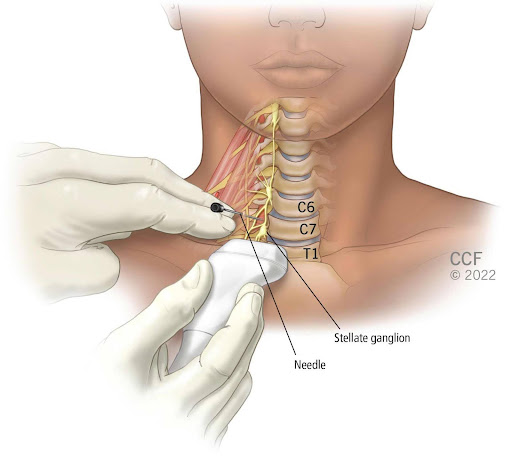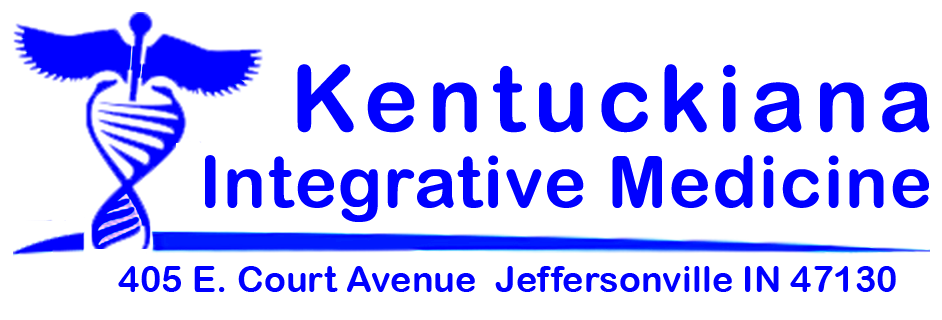STELLATE GANGLION BLOCK FOR “OFF LABEL USE” IN PTSD, DEPRESSION, PAIN & LONG COVID

What Does a Stellate Ganglion Block Treat?
Doctors use stellate ganglion blocks to diagnose or treat nerve injuries or issues with circulation as well as some “off label” uses described below. The conditions treated with Stellate Ganglion Block Injections include:
- CRPS -Complex regional pain syndrome (type I or II)
- Reflex sympathetic dystrophy (long-term pain after an injury, stroke, or heart attack)
- PTSD “off label”
- Depression “off label”
- Anxiety “off label”
- Long Covid “off label”
- Chronic Pain
- Neuropathic Pain
- Cluster Headaches
- Meniere’s Disease
- Oral and facial Pain
- Atypical Chest Pain
- Chronic Post-Surgical Pain
- Peripheral Artery Disease
- Causalgia (an intense burning sensation)
- Shingles affecting your head, neck, arm, or upper chest.
- [Shingles Post Herpetic Neuralgia]
- Raynaud Syndrome
- Phantom limb pain
- Intractable Angina
- Refractory Cardiac Arrythmias
- Scleroderma
- Hyperhidrosis – Excessive Sweating
Stellate ganglion blocks may also help in the treatment of certain mental health conditions, like posttraumatic stress disorder (PTSD), anxiety, and depression.
Some studies suggest the procedure is helpful. However, other studies show no link between stellate ganglion blocks and mental illness. Researchers need more data to confirm whether the procedure helps these conditions. Nevertheless, some patients are responding with excellent results.
The stellate ganglion is a collection of sympathetic nerves in your neck. They’re found on either side of your voice box. You can get an injection called a stellate ganglion block or (sympathetic nerve block) to ease pain in your neck, head, upper chest, and upper arm. It can also help with circulation and blood supply to your arm, as well as the conditions listed above.
COST: The estimated cost of two stellate ganglion block injections is about $2,000. Pricing varies from clinic to clinic and on the number of treatments you need.
How Do Doctors Perform a Stellate Ganglion Block?
Your doctor might give you an intravenous (IV) medication to calm you down before the procedure. They’ll need to press on your neck to find the right injection spot. This might feel slightly uncomfortable.
You will be placed on an examination table. Your doctor will clean your neck with antiseptic before they insert a thin needle to inject a local anesthetic near your voice box. This may burn or sting a little while injected. Doing so could cause the needles to move.
Your doctor will use fluoroscopy or ultrasound guidance to insert a second needle. They’ll inject an anesthetic medication. If your pain is in your head, your doctor will keep you lying down on your back. If your symptoms are in your arm, they’ll have you sit up so the medication can move down.
A stellate ganglion block usually takes less than 30 minutes. After the procedure, your care team will have you wait in a recovery room. You’ll be able to go home on the same day as the injection.
Procedure Anxiety – Conscious Sedation:
For most patients, the procedure is very well tolerated. For those with serious procedure anxiety, many clinics offer conscious sedation with Nitrous aka “laughing gas” or IV versed. Ask your doctor if the clinic offers conscious sedation.
How Effective Are Stellate Ganglion Blocks?
After the procedure, some people notice pain relief right away. But your pain may come back a few hours after the local anesthesia wears off. In other cases, people have reported that their pain stays away even after the local anesthesia wears off for months. You might not notice symptoms for days or weeks. In these cases, people might not need as much medication. They may also be able to be more active with physical therapy if desired.
Pain or PTSD relief etc. from a stellate ganglion block varies for everyone. In some cases, the patient will need more than one injection to continue to keep the pain away. This may mean only a couple of injections. Occasionally, some patients need up to 10 or more. If the procedure works for you, your doctor may suggest you get a series of stellate ganglion blocks every 1-2 weeks. Usually, your pain-free period will be longer after each treatment.
Are There Any Risks or Side Effects With Stellate Ganglion Blocks?
It’s not safe to have a stellate ganglion block if you currently have a fever, cold, cough, infection, the flu, very high blood pressure, or if you’re on blood thinners. Let your doctor know right away if you think these may be concerns for you. Serious complications after a stellate ganglion block are uncommon, but these risks include infection, bleeding, or nerve damage. Other infrequent complications can include seizures, collapsed lungs, or allergic reactions to the medication. You might have slight bruising or soreness around the area of the injection, though. Other side effects from the procedure may include:
- Tearing up
- Bloodshot (red) eyes
- Droopy eyelids (which could affect your balance)
- Stuffy nose
- A hoarse voice
- The feeling of a lump in your throat
- Difficulty swallowing
- A tingly, numb, heavy, or warm feeling in your hand or arm
The above side effects usually go away within 4-6 hours.
Aftercare for Your Stellate Ganglion Block
Once your procedure is over, you’ll want to stay away from any hard activities for 24 hours. It’s best to rest. Don’t drive for the rest of the day. You can continue your normal schedule the next day.
After a stellate ganglion block, your voice MAY sound different briefly. Once it returns to normal, you can start to sip water through a straw. Don’t eat or drink anything for 4 hours after the procedure until you can safely swallow. Slowly work your way up to eating solid food.
If you notice severe pain, weakness in your arm, new numbness, a fever of 100.5 or more, or any signs of an infection around your injection, GO TO THE EMERGENCY DEPARTMENT. These symptoms aren’t normal and require medical attention.
Long COVID and Stellate Ganglion Blocks
Stellate ganglion blocks might also be able to treat long COVID symptoms. The research on this is new but promising.
Long COVID symptoms include:
- Fatigue
- Brain fog
- Anosmia (loss of smell)
- Dysgeusia (change in taste)
- Orthostatic intolerance (unpleasant symptoms that happen after standing up from a lying or sitting position)
Stellate ganglion blocks lead to more blood flow. This can, in turn, ease long COVID symptoms.
A stellate ganglion block [SGB] is an injection of medication into a collection of nerves at the bottom of the front side of your neck. It can help treat a variety of circulation and pain conditions, such as complex regional pain syndrome and peripheral artery disease. Researchers are studying how it may help mental health conditions like PTSD, Anxiety, and Depression. Physicians with advanced training at progressive clinics are using a stellate ganglion block injections “off label” to help patients with resistant depression, PTSD, anxiety, Long Covid, circulation issues and chronic pain, neuropathic pain issues with variable results from excellent within minutes to non-responsive.




